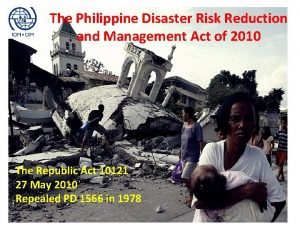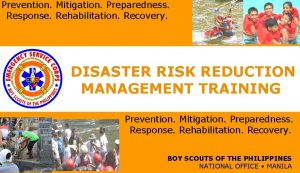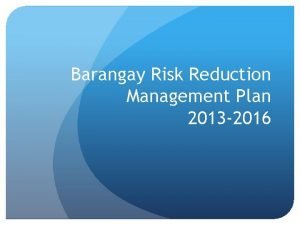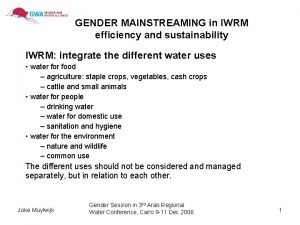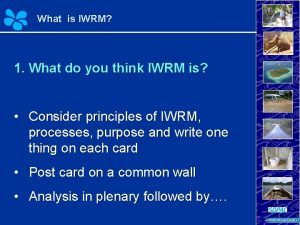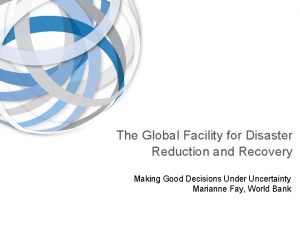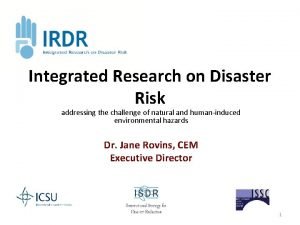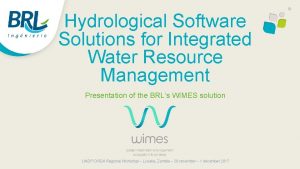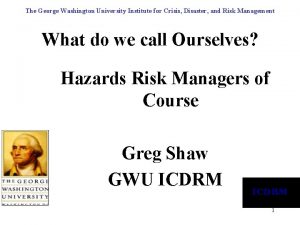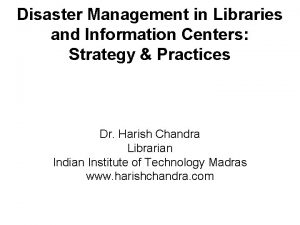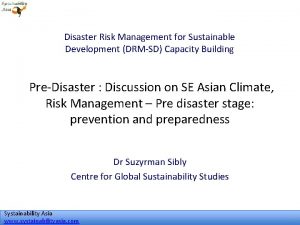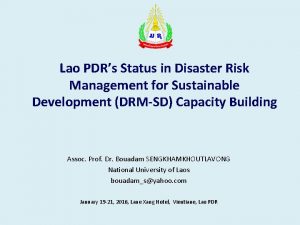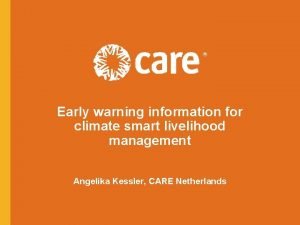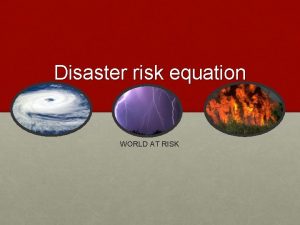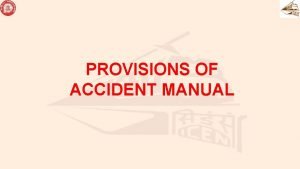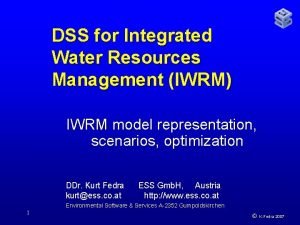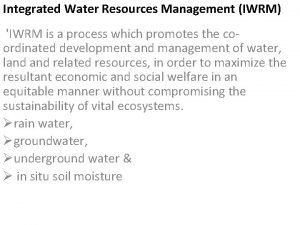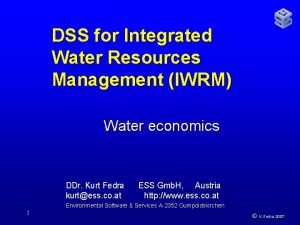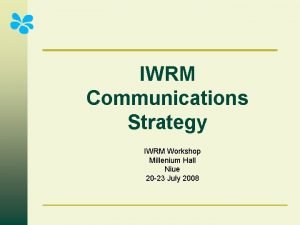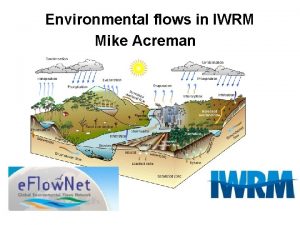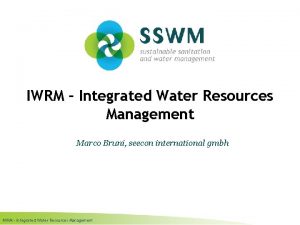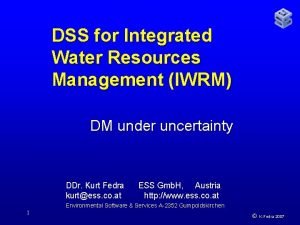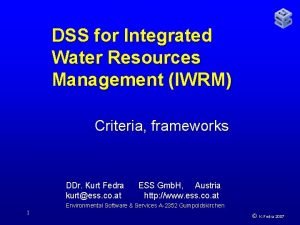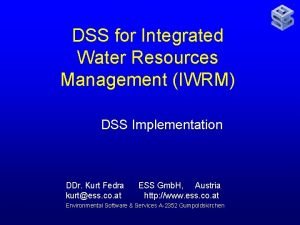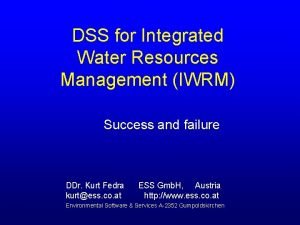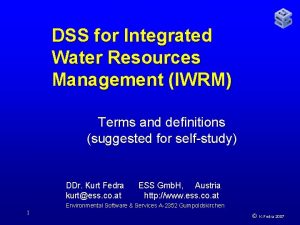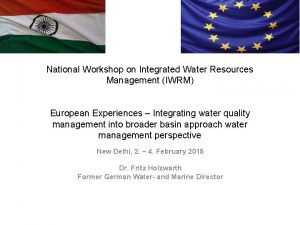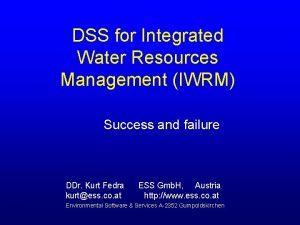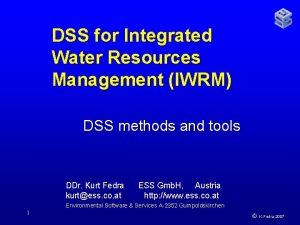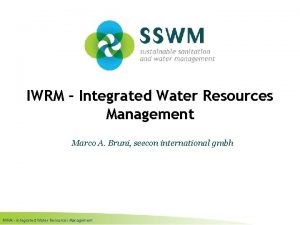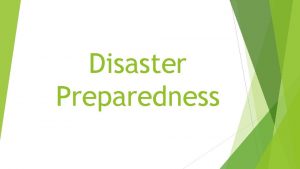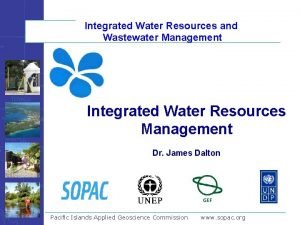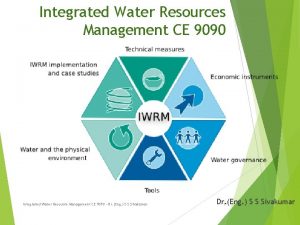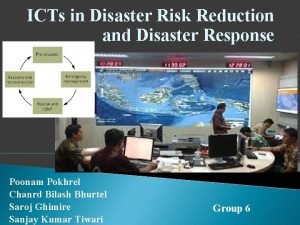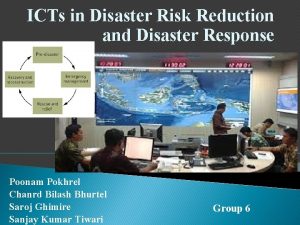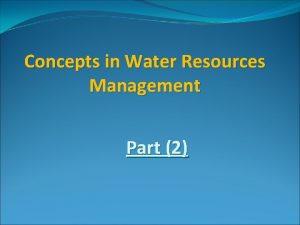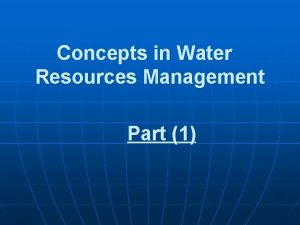Integrated Water Resource Management IWRM and Disaster Reduction




























- Slides: 28

Integrated Water Resource Management (IWRM) and Disaster Reduction Chris Hartnady & Rowena Hay Umvoto Africa (Pty) Ltd Africa Regional Consultation on Disaster Reduction Johannesburg, 2 -3 June 2004

Water Cycle Science Understand fluxes and storage of water as it moves through the hydrologic cycle & associated fluxes of solutes, sediments, and energy v Monitor and understand change, if any, in the quantity and quality of water v Test hypotheses and models, formulate new hypotheses (traditional scientific use) v

Water-related (Geo)Hazards v Floods (“Hydrometeorological” hazard) Extreme precipitation events and/or river flooding v Coastal storm surge v Dam failure v v Ground Instability Landslides and mass-wasting (water-induced) v Subsidence and collapse v v Carbonate dissolution v Fluid withdrawal Earthquakes (fluid pressure-triggered) v Droughts and desertification v Global climate change (effects on hydrological cycle) v

Flood cause and consequence Sudden-onset wide area event triggered by extreme weather - river flooding at Ashton, Western Cape, RSA March 2003

Integrated Water Resources Management v IWRM (inception at 1992 Dublin conference) v people- and environment-focused, holistic paradigm by which to regulate and manage water v breaks down boundaries of sector, scale and discipline to ensure that water is managed v at the most appropriate level v by the most appropriate people v in a manner that acknowledges the rights of other uses and users (“Whiskey is for drinking, but water is for fighting over”)

Eight Dublin principles 1. 2. 3. 4. 5. 6. 7. 8. Conserve and protect water sources and catchments as essential to life, health and socio-economic productivity Agree on fair and equitable water allocations between stakeholders within broad national framework Manage at lowest appropriate level Build human capacity as key to resource sustainability Involve all stakeholders actively at all stages Use water efficiently (often an important “source” in itself ) Value water as both economic and social good Strike a gender balance in water management

IWRM philosophy v “IWRM is a philosophy of co-ordinated management of an area’s water, land other resources to maximize economic and social welfare in an equitable manner without compromising the sustainability of the resource and vital ecosystems” South African Department of Water Affairs and Forestry (DWAF) brochure

Disaster Reduction v World Conference on Natural Disaster Reduction (May 1994, Yokohama Japan) adopted “Yokohama Strategy and Plan of Action for a Safer World”, based on ten principles v 2 nd WCDR (Kobe, Japan, January 2005) provides opportunity for a comprehensive review of the Yokohama Strategy

Principles of Yokohama Strategy 1. 2. 3. 4. 5. 6. 7. 8. 9. 10. Risk assessment a required step for DR Disaster prevention and preparedness (DP&P) of primary importance DP&P integral aspects of development policy and planning all levels Capacities to prevent, reduce and mitigate disasters a top priority Early warnings of impending disasters, effective dissemination, key factors Effective community participation at all levels Vulnerability reduced by proper design and patterns of development, appropriate community education and training International community to share necessary technology, freely available in timely manner, as integral part of technical cooperation Environmental protection as component of sustainable development consistent with poverty alleviation, imperative Each country bears primary responsibility for protecting people, infrastructure, other national assets. International community should … mobilize adequate … resources, bearing in mind needs of developing countries, particularly least developed countries

Linking IWRM and Disaster Reduction v Dublin (D) and Yokohama (Y) intersections v Integration of (resource) development-planning and risk-assessment processes (D 1, D 7, Y 1, Y 3, Y 7, Y 9) v Prioritization of prevention and preparedness (D 1, Y 2 -Y 7) v Emphasis on cooperation and communication at all levels (D 1, D 2, D 5, D 8, Y 6, Y 8) v Importance of building human capacity (D 4, D 8, Y 4, Y 7) v Implicit need for conflict resolution (D 2, D 5, Y 6, Y 7)

Possible Flagship Project(s) v Link to IGOS-P Geohazards Theme Precipitation / geosphere moisture content related to climate change, provides triggering mechanism for landslides and other ground deformations v Deep groundwater infiltration triggers strong earthquakes in Southern African neotectonic zones (e. g. , Kariba) v Integration of Southern African weather, climate, hydro(geo)logical, space-geodetic & seismological observing systems, along with satellite remote-sensing and geo-informatics technologies, is required v Cross-cutting collaborations possible with IGOS-P Water Cycle Theme (floods) and Ocean Theme (tsunamis and coastal flooding) v

Existing platform? v SA Dept of Land Affairs Trig. Net Array v Continuous GPS v often co-located with weather stations v can monitor v crustal motions to mm/yr precision v water vapour in troposphere

GEO initiative v Ad-hoc Group on Earth Observation v Co-chaired by South Africa (DST), with “developing nation” interests, following WSSD v Aims to establish a Global Earth Observation System of Systems v UN/ISDR is observer member of GEO v “Water” and “Disasters” are among 9 focus topics in current activities of GEOSS Implementation Plan Task Team (IPTT) v Flood forecasting and an integrated (satellitebased, ground-calibrated) global monitoring system for droughts – among priority requirements

Flood forecasting “… the costliest and deadliest hazards worldwide …” v Warning and protection systems incorporate geostationary satellite precipitation fields in conjunction with hydrological models, statistically calibrated to particular locations v Maximizing effectiveness of precipitation observations in flood prediction v near real-time instantaneous microwave and auxiliary (microwave-calibrated geosynchronous–infrared, etc. ) rain products at the sensor resolution v uncertainty characterization of instantaneous microwave precipitation products v

IWRM and Groundwater resources provide alternative decentralised approaches to water supply, which Ø generally existed before big (surface-water) schemes and projects involving large-scale damming of river systems Ø were often replaced and rendered dysfunctional by major surface-water supply projects Ø are now finding their way back into the mainstream of water supply options Ø often are the last resort or relief under drought conditions

Groundwater & Climate Change v v v Underground reservoirs (aquifers) are evaporation free and therefore will have increasing marginal advantage under conditions of global warming Most are recharged annually (artificially in rare cases) Some aquifers have potentially large, natural storage volume, well in excess of annual recharge Many can be managed conjunctively with surface water reservoirs (an “excellent example of IWRM in practice” – DWAF, South Africa) UNESCO/WMO-IGRAC - General lack of information about groundwater resources should stimulate national and regional efforts in monitoring and assessing aquifer systems

GRACE for Southern Africa v Gravity Recovery And Climate Experiment satellite mission – co-PI: Byron Tapley (UT Austin) “GRACE's trump card is its ability to measure the changes in gravity caused by the movements of water. The satellites can detect changes in groundwater and river basins, which are crucial for farmers and environmental scientists. GRACE should be able to measure a 4 millimetre change in water height across the 32 million square kilometres of the Mississippi river basin” v “Eventually, ” says Tapley, “we will be able to let countries in Africa know how their aquifers are changing”. v National Geogaphic Magazine quote

Water-related conflict v “Water is one of the most important ingredients for development and stability. Without access to basic water supplies, disease and ill-health, poverty, environmental degradation and even conflict may be the result – all of which lead, in turn, to greater water stress. Water-related conflict does not have to take on the attributes of war in order to be debilitating – it can fester between groups, ignite between neighbouring farmers or industrialists, and can cause loss of trust between people and their governments. When water conflict erupts between sovereign states, the victims may not perish on any clearly discernible battlefield, but the people and the watercourse itself will suffer the consequences of the absence of either co-operation or communication between those sharing a basin. ” Mikhail Gorbachev, President of Green Cross International

End “Better water storage monitoring on a global scale should also help scientists improve our ability to predict, plan for, and respond to extreme events, such as floods and drought” Alan Ward NASA Earth Observatory 2003 December 23 v Thank you


Dublin challenges 1 -2 1. Inadequate frameworks to ensure communication and cooperation in water source and catchment conservation between different sectors and levels. Focus remains on limited interventions close to source 2. Reality of conflict between competing uses and users often glossed over. Stakeholders a. b. involved mostly at information, not decision making level lack good, appropriately presented hydro(geo)logical information essential to informed decision making.

Dublin challenges 3 -4 3. Unavailable / unclear / confusing frameworks for management at lowest appropriate level. Community-based approaches now accepted as norm, but do local governments & user association have necessary structures and capacity? 4. Uneven / ineffective / unmonitored capacity building. Proper monitoring essential to effective CB programmes a. Do they pay sufficient attention to lower and intermediate levels within decentralised support agencies? b. Are they able to fulfil role in facilitating user decision

Dublin challenges 5 -6 5. Limited / narrow-focus / uninterested stakeholder involvement in wider IWRM, because of a. b. c. d. e. 6. high transaction costs lack of genuine decision-making power purely consultative form of community involvement multiple perspectives and agendas of water users ineffective mechanisms for conflict resolution Low emphasis on efficient water use Important to integrate demand management into projects and decisions. Water generally valued most highly where scarcest, or where tariff structures make waste expensive

Dublin challenges 7 -8 7. Poor perspective on role of water as social good. Principle of paying for water widely accepted and many projects introduce user charges, but rights of vulnerable, poverty-stricken groups still need protection in planning for cost recovery 8. Striking absence of women within staff of support agencies. Do we understand how gender encompasses other important aspects of community dynamics such as age, wealth, class, cast, etc. ?

Principles of Yokohama Strategy 1. 2. 3. 4. Risk assessment a required step for adoption of adequate and successful disaster reduction policies and measures Disaster prevention and preparedness (DP&P) of primary importance in reducing need for disaster relief DP&P integral aspects of development policy and planning at national, regional, bilateral, multilateral and international levels Development and strengthening of capacities to prevent, reduce and mitigate disasters a top priority

Yokohama Strategy Principles (2) 5. 6. 7. Early warnings of impending disasters and effective dissemination using telecommunications, including broadcast services, key factors to successful DP&P Preventive measures most effective when involving participation at all levels, from local community through national government to regional and international level Vulnerability reduced by application of proper design and patterns of development focused on target groups, by appropriate education and training of the whole community

Yokohama Strategy Principles (3) 8. 9. 10. International community to share necessary technology to prevent, reduce and mitigate disaster; made freely available in timely manner as integral part of technical cooperation Environmental protection as component of sustainable development consistent with poverty alleviation, imperative in prevention and mitigation of disasters Each country bears primary responsibility for protecting people, infrastructure, other national assets from impact of natural disasters

International Community Role 10. (cont. ) International community should demonstrate strong political determination to mobilize adequate and make efficient use of existing resources, in the field of natural disaster reduction, bearing in mind needs of developing countries, particularly least developed countries
 Water and water and water water
Water and water and water water Philippine disaster reduction and management act
Philippine disaster reduction and management act National disaster risk reduction and management framework
National disaster risk reduction and management framework Bdrrm plan message
Bdrrm plan message Iwrm toolbox
Iwrm toolbox Iwrm adalah
Iwrm adalah Iwrm definition
Iwrm definition Socio economic trends
Socio economic trends Integrated research on disaster risk
Integrated research on disaster risk Water resource management software
Water resource management software Water resource
Water resource Resource leveling is the approach to even out the peaks of
Resource leveling is the approach to even out the peaks of Perbedaan resource loading dan resource levelling
Perbedaan resource loading dan resource levelling Time management in human resource management
Time management in human resource management Retail management retail store organizational chart
Retail management retail store organizational chart Function of personnel management
Function of personnel management George washington crisis management
George washington crisis management Disaster management in libraries and information centres
Disaster management in libraries and information centres Disaster management and sustainable development
Disaster management and sustainable development Water reduction
Water reduction Conclusion of disaster management
Conclusion of disaster management Early warning system in disaster management
Early warning system in disaster management Risk equation in disaster management
Risk equation in disaster management Records management disaster recovery plan
Records management disaster recovery plan Vulnerability disaster management
Vulnerability disaster management Disaster management centre sri lanka
Disaster management centre sri lanka Civil defence disaster management
Civil defence disaster management Man made disasters conclusion
Man made disasters conclusion Disaster management
Disaster management

